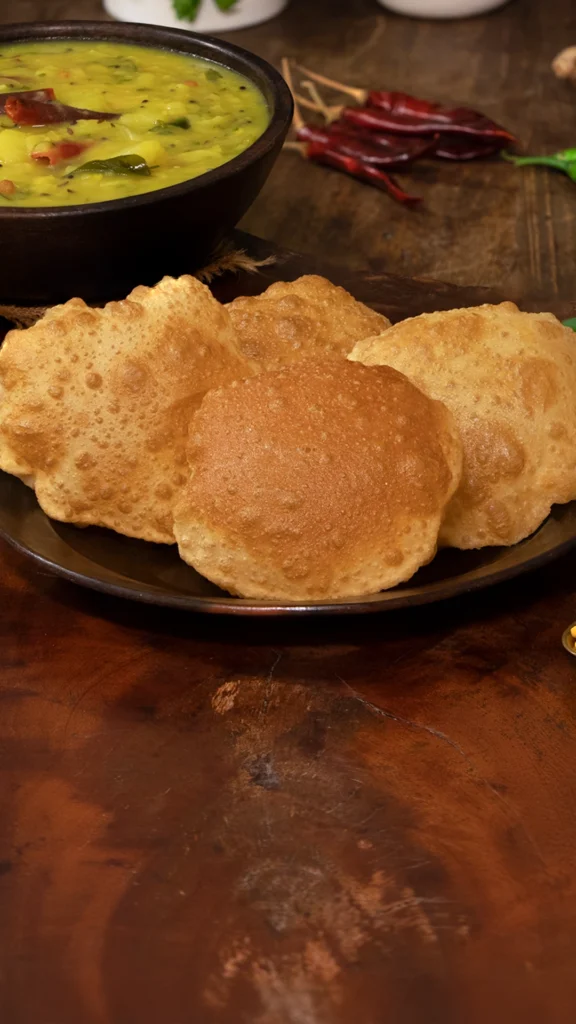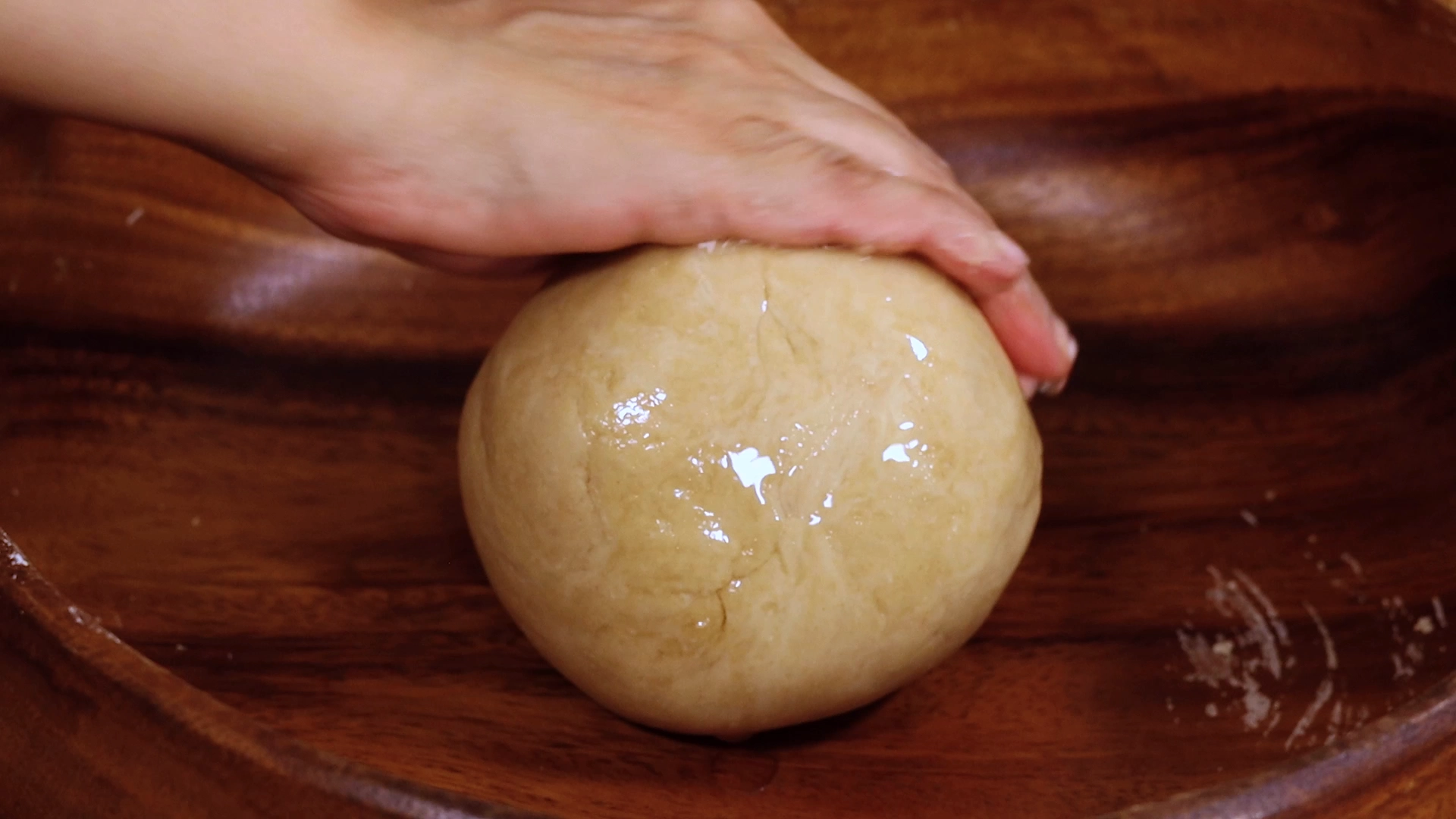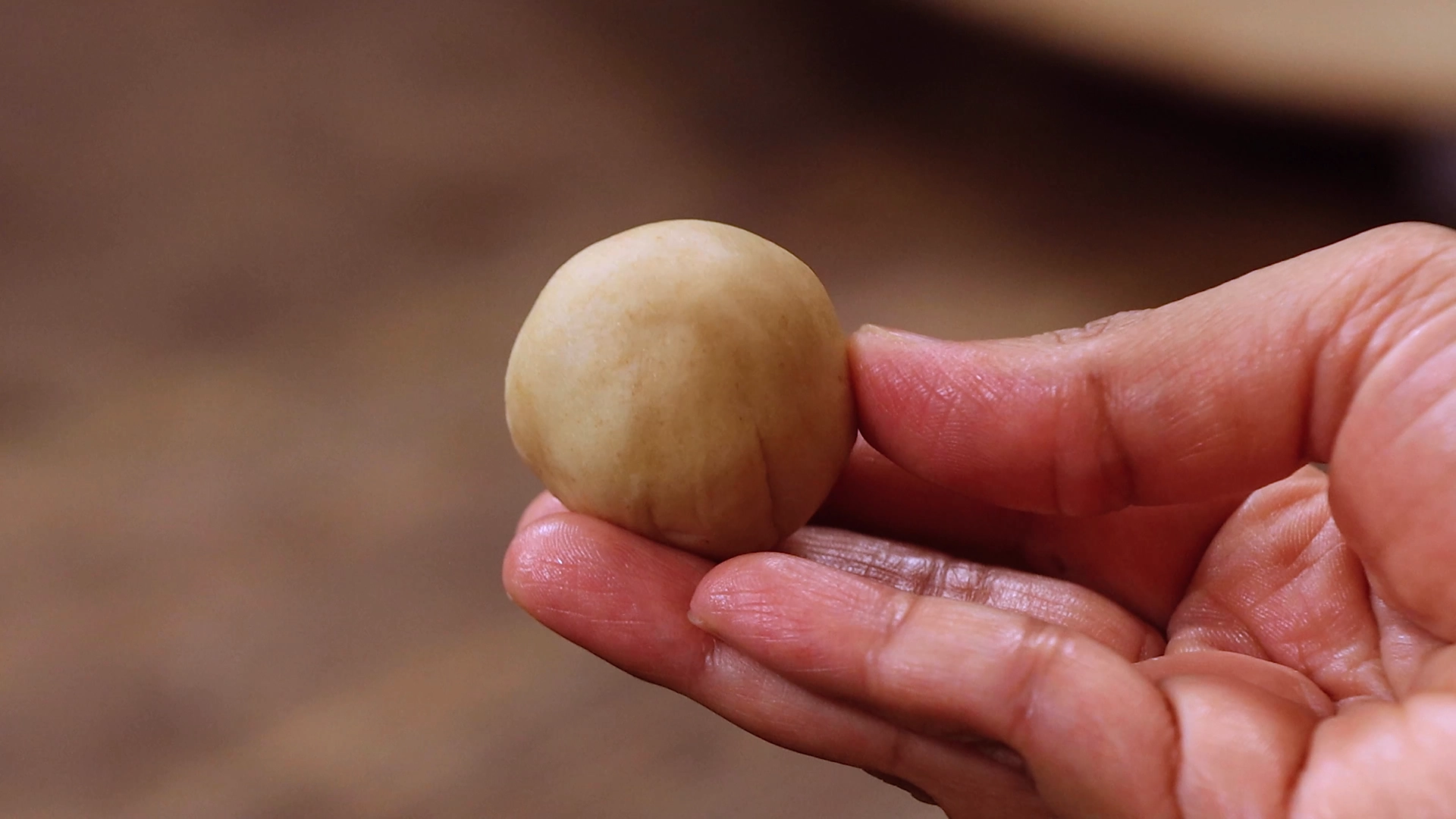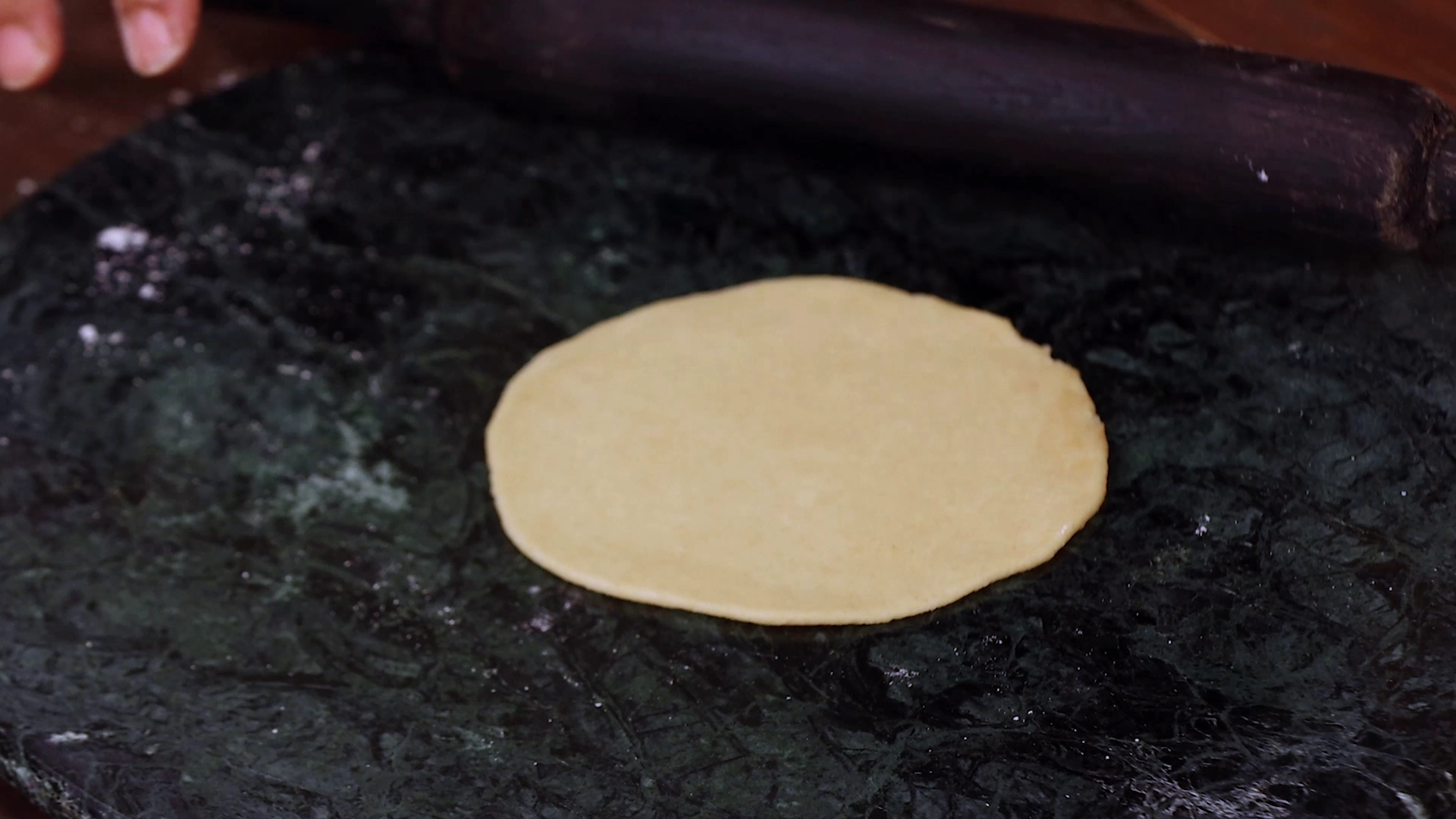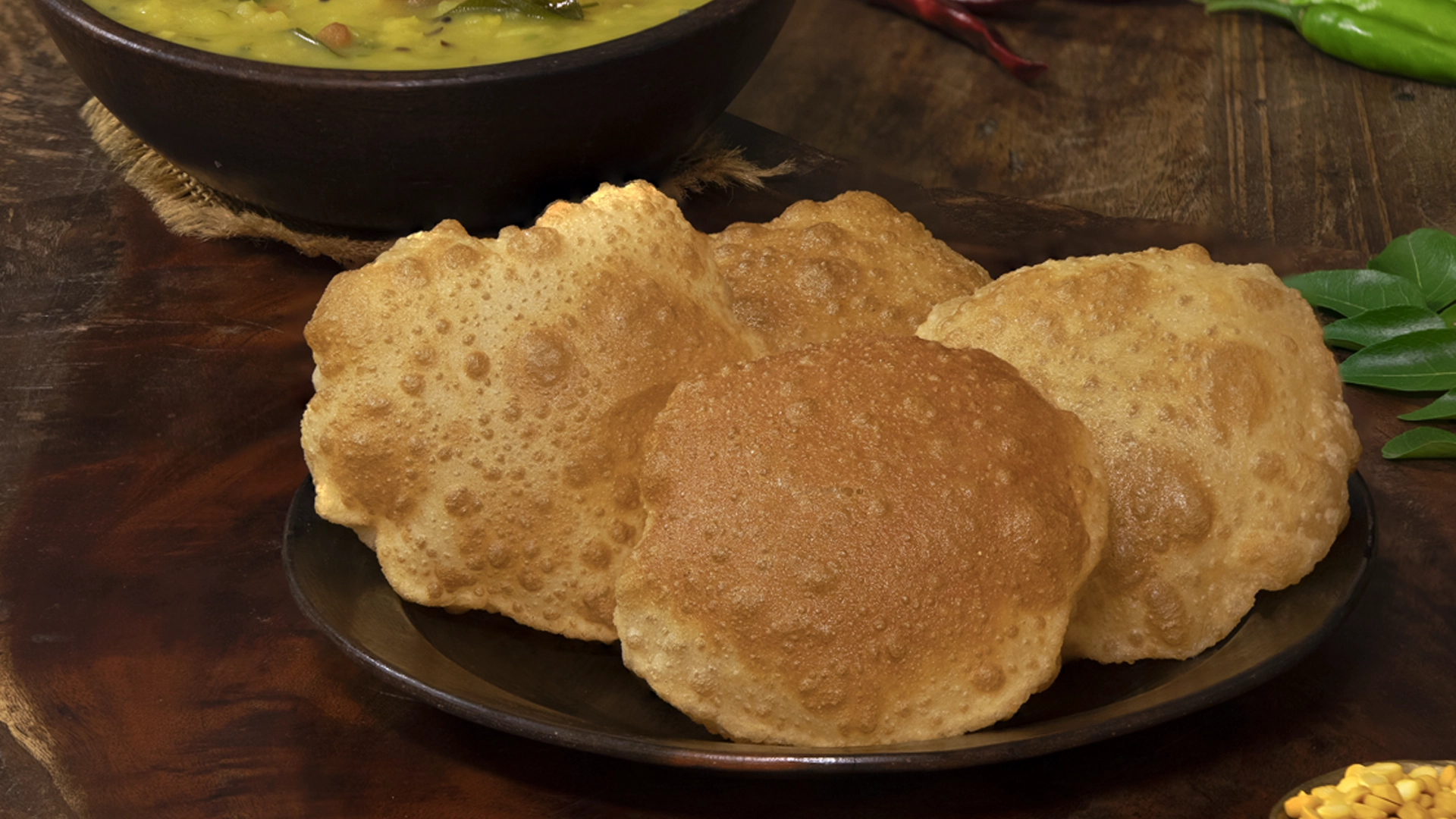Soft, fluffy, and golden brown, Poori (or Puri) is one of the most beloved Indian breads. It’s deep-fried to perfection, puffing up into an airy, light, yet crisp delight. Whether you call it poori or puri, this versatile bread pairs beautifully with a variety of curries, gravies, and sabzis. But the ultimate classic pairing? Aloo Bhaji—a lightly spiced, comforting potato curry that turns this meal into pure bliss.
This combination is not just a breakfast favorite—it’s a go-to meal for festivals, special occasions, and family gatherings. The crispy poori, when torn apart and dipped into the warm, fragrant potato bhaji, creates a flavor explosion that’s hard to resist!
What Makes Poori Great?
Poori is a simple yet magical bread—crispy on the outside, soft on the inside, and perfectly puffed when fried. But what gives it that signature texture and flavor? Let’s break it down!
- Wheat Flour – The backbone of poori! Whole wheat flour gives it a hearty, slightly nutty flavor while keeping it soft yet chewy. It also helps the pooris puff up beautifully when fried.
- Salt – A small but essential ingredient that enhances the natural taste of the wheat flour. Without it, pooris can taste bland.
- Oil (for the dough) – Adding a bit of oil makes the dough smoother and helps create that light, airy texture in the pooris. It also prevents them from getting too hard after frying.
- Water – The right amount of water ensures a firm yet pliable dough. Too much, and the pooris absorb oil. Too little, and they become tough.
- Oil (for frying) – The secret to perfectly puffed pooris is frying them in hot oil at just the right temperature. If the oil is too cold, they turn greasy. If it’s too hot, they brown too fast without puffing up.
What Makes Aloo Bhaji Special?
Aloo Bhaji isn’t just mashed potatoes—it’s a flavorful, comforting dish packed with aromatic spices and a hint of spice. Here’s what makes it special
- Potatoes – The star of the dish! They soak up the spices beautifully, turning soft, creamy, and flavorful.
- Urad Dal & Chana Dal – Adds a slight crunch, making the bhaji more interesting in texture.
- Mustard Seeds & Cumin Seeds – These tiny seeds bring a burst of earthy, nutty flavors and enhance the aroma of the dish.
- Red & Green Chilies – The perfect balance of heat! Red chilies add warmth, while green chilies bring a fresh, spicy kick.
- Curry Leaves – A must-have for South Indian flavors, adding a distinctive aroma and slight crispiness.
- Onions & Ginger – The sweetness of onions and the warmth of ginger create depth of flavor. Ginger also helps digestion, making the dish feel lighter.
- Turmeric & Asafoetida (Hing) – Adds a beautiful golden color and a mild bitterness that balances the richness of potatoes. Hing also helps with digestion.
- Besan (Gram Flour) – A game-changer! It slightly thickens the bhaji, making it creamy while adding a subtle nutty taste.
- Coriander Leaves – A fresh, herby finish that enhances the overall taste.
With these carefully chosen ingredients, Poori Bhaji is the perfect balance of crispy, fluffy, spicy, and comforting flavors!
Making Crispy and Puffy Pooris – A Step-by-Step Guide
Making the Perfect Poori
Start with whole wheat flour in a mixing bowl. Add a pinch of salt for taste and a little oil to make the dough soft and pliable. Slowly add water and knead until it forms a smooth, firm dough. Pro Tip: The dough should be firm, not sticky—so don’t add too much water. A soft dough will absorb excess oil while frying, making the pooris greasy.
Once done, let it rest for about an hour—this helps the gluten relax, making rolling easier. Pro Tip: If you’re in a hurry, let it rest for at least 20 minutes. But don’t skip this step! Resting ensures the pooris roll out easily and puff up beautifully.
After resting, divide the dough into small portions and roll them out into discs. Make sure the edges are slightly thinner than the center—this helps them puff up evenly when fried.
Heat oil in a kadai until it’s hot but not smoking. Pro Tip: To test if the oil is ready, drop a small piece of dough into the oil—it should rise immediately without turning brown too fast.
Now, gently slide in a poori and press it lightly with a slotted spoon to help it puff up. Flip and fry until golden brown, then drain on a paper towel. Pro Tip: Avoid stacking pooris on top of each other, as the steam will make them soggy.
Cooking the Aloo Bhaji
While the dough is resting, get started on the bhaji. Heat oil in a kadai and add urad dal and chana dal—these add a slight crunch to the dish. Once golden, throw in cumin and mustard seeds. When the mustard seeds start popping, add dried red chilies, slit green chilies, and fresh curry leaves. Pro Tip: Adding the curry leaves at this stage enhances the aroma of the dish, so don’t skip it!
Next, add thinly sliced onions and sauté until soft. Stir in freshly pounded ginger for a mild heat and depth of flavor. Now comes the spice mix—turmeric for color, asafoetida for digestion, and salt to bring it all together. Give it a quick stir before adding the star ingredient—boiled and mashed potatoes. Pour in some water to loosen it up and let everything simmer so the potatoes soak up all the flavors.
For a thick, luscious texture, mix some gram flour (besan) with water and pour it in. Stir quickly to avoid lumps, and cook for a couple more minutes. Pro Tip: The besan mixture helps thicken the bhaji and gives it a slight nuttiness.
Finish with freshly chopped coriander for a burst of freshness.
How to Serve Poori and Bhaji?
Poori Bhaji is a versatile dish that can be served in multiple ways, depending on your preference!
The traditional way to enjoy poori is with aloo bhaji, but it also pairs wonderfully with other curries and gravies. If you’re in the mood for something different, try it with chana masala—the hearty, spiced chickpea curry adds an extra layer of richness. You can also serve it with tomato curry or a flavorful vegetable kurma for variety.
Aloo Bhaji Beyond Pooris
Don’t limit aloo bhaji to just pooris! This flavorful potato dish makes an excellent stuffing for masala dosa—spread it inside a crisp dosa, and you have an instant South Indian classic. It can also be used as a filling for sandwiches or wraps for a quick and satisfying snack.
Packing for Lunch Boxes
If you want to pack poori bhaji for lunch, here’s how to keep it fresh
- Let the pooris cool completely before packing—this prevents them from getting soggy. Wrap them in parchment paper or place them in an insulated container to keep them warm.
- Store the bhaji separately in a spill-proof container. If it thickens by lunchtime, add a splash of warm water and stir.
- For an extra crunch, pack a side of pickle or fried green chilies. A simple cucumber raita also makes a refreshing side.
💡 Pro Tip: If packing for kids, cut the pooris into smaller pieces and mix with bhaji for an easy-to-eat meal.
Poori
Ingredients
To make poori
Instructions
Prep Work
-
In a large bowl, mix wheat flour and salt, then add oil and mix well. Gradually add water and knead into a smooth dough.
-
Cover the dough with a lid and let it rest for 1 hour for better texture.
-
After resting, divide the dough into small balls for rolling.
Method
-
In a kadai, heat oil on medium-high flame until hot
-
Roll each dough ball into a small circle, making sure the edges are thinner than the center.
-
Once the oil is hot, gently drop in the poori. Flip it gently to fry evenly until golden brown.
-
Remove from the oil and place on a paper towel to drain excess oil. Serve hot.
Nutrition Facts
Servings 4
- Amount Per Serving
- Calories 180kcal
- % Daily Value *
- Total Fat 8g13%
- Saturated Fat 1.2g6%
- Sodium 240mg10%
- Potassium 78mg3%
- Total Carbohydrate 24g8%
- Dietary Fiber 2.5g10%
- Sugars 0.5g
- Protein 4g8%
- Calcium 12 mg
- Iron 1.1 mg
- Magnesium 28 mg
* Percent Daily Values are based on a 2,000 calorie diet. Your daily value may be higher or lower depending on your calorie needs.

